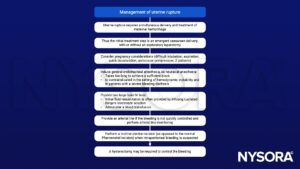Learning objectives
- Description of a uterine rupture
- Management of a uterine rupture
Definition and mechanisms
- Uterine rupture refers to a complete division of all three layers of the uterus: the endometrium (inner epithelial layer), myometrium (smooth muscle layer), and perimetrium (serosal outer surface)
- Typical rupture occurs during labor, but it may occasionally happen earlier in pregnancy
- The fetus is left without the protection of the uterus, leaving the fetus without oxygen and causing the fetus’s heart rate to slow down
- Suspect uterine rupture based on a rapid drop in the baby’s heart rate during labor
- The cardinal sign of uterine rupture is loss of fetal station on a manual vaginal exam
- The maternal mortality rate is < 1%, fetal mortality rate is between 2-6 %
- Incomplete rupture:
- Peritoneum is still intact
- Complete rupture:
- All three layers are ruptured
- The contents of the uterus spill into the peritoneal cavity or the broad ligament
- Bladder injury is not uncommon with uterine rupture
- A caesarean section is recommended in women who have had a prior rupture
Signs and symptoms
- Vaginal bleeding
- Abdominal pain and tenderness
- Chest pain, pain between the scapulae, or pain on inspiration
- Hypovolemic shock
- Signs associated with fetal oxygenation:
- Late deceleration
- Reduced variability
- Tachycardia
- Bradycardia
- Absent fetal heart sounds
- Cessation of uterine contractions
- Palpation of the fetus outside the uterus (usually occurs only with a large, complete rupture)
Risk factors
- History of uterine surgery
- Previous uterine rupture
- Uterine trauma
- Congenital uterine anomalies such as septate uterus or bicornuate uterus
- Vaginal birth after caesarean section
- Trauma
- Cocaine use
- Stretch uterus (multiples or too much amniotic fluid)
- A breech position requiring external cephalic version
- Pronged labor
Complications
| Maternal | Fetal |
|---|---|
| Major maternal blood loss A higher risk of Coagulopathy Longer fetal exposure to hypoxia Hysterectomy | Intraventricular hemorrhage Seizures Brain ischemia Death |
Diagnosis
- Laboratory tests:
- Hemoglobin or hematocrit
- Coagulation tests (prothrombin time, activated partial thromboplastin time, fibrinogen, thromboelastogram)
- Ultrasound
- To rule out placenta praevia, placental abruption, or spontaneous abortion
- To support the diagnosis: abnormality in the uterine wall, a hematoma next to hysterotomy scar, free fluid in the peritoneum, anhydramnios or fetal parts outside the uterus
Management

Suggested reading
- Gibbins KJ, Weber T, Holmgren CM, Porter TF, Varner MW, Manuck TA. Maternal and fetal morbidity associated with uterine rupture of the unscarred uterus. Am J Obstet Gynecol. 2015;213(3):382.e1-382.e3826.
- Plaat F, Shonfeld A. 2015. Major obstetric haemorrhage. BJA Education. 15;4:190-193.
- Walfish M, Neuman A, Wlody D. 2009. Maternal haemorrhage. BJA:: British Journal of Anaesthesia. 103;1:47-56.
- Guiliano M, Closset E, Therby D, LeGoueff F, Deruelle P, Subtil D. Signs, symptoms and complications of complete and partial uterine ruptures during pregnancy and delivery. Eur J Obstet Gynecol Reprod Biol. 2014;179:130-134.
We would love to hear from you. If you should detect any errors, email us [email protected]








